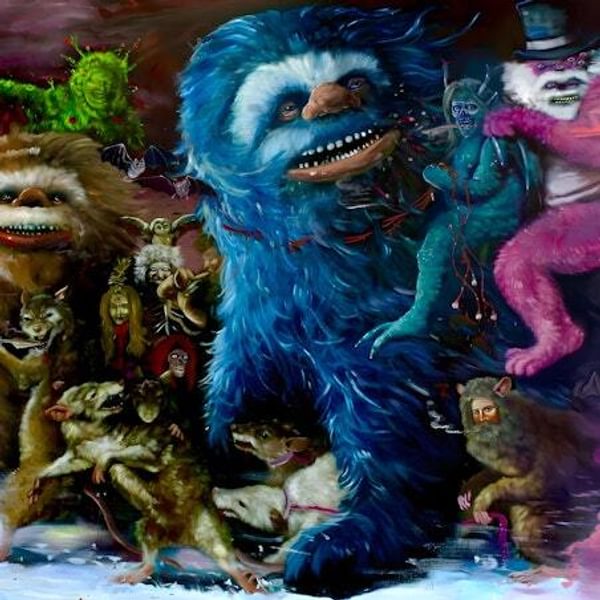
On the Rise
green star
From post-dictatorship underground punk to macabre childhood games through Romanticism Era writing, green star’s north stars are as unlikely as their fateful cross-continental formation.
In the USA in the early 2000s, a dancer spent their childhood enveloped in music. In Spain in the early 2000s, one producer and one videographer watched family members build guitars, and a mother was a part of an underground punk scene that sprouted after a toppled dictatorship circa 1975. Who could have guessed their paths would cross? It must have been written in the stars.
That childhood dancer is green star vocalist Lilah Bobak, who picked up the art when she was three years old. Spending years dancing around sound, pushing through blisters and calluses, moving to the beat, it didn’t just welcome her with open arms in the dance studio – it followed her home. “My dad plays guitar and my mom used to sing so I was always around music,” Bobak tells me. Music called to her – not just to move to, but to create: “I really liked the idea of being in a band and having that community creative aspect with music, because in my dance journey as a dancer, as a choreographer, I work alone and independently.”
And yet, Bobak’s strict schedule prevented her from going further than dabbling with instruments “a little bit here and there,” and it wasn’t until she had decided to uproot her life and study dance in London did she see an opportunity awaiting her. “Part of the reason why I wanted to study dance in London was because of the music scene,” Bobak reminisces. And it wasn’t until a year ago, that she said to herself, “‘I’m just going to make this happen somehow,’” and thought, “‘Let’s just put a silly ad on Join My Band.’”
The ad was answered by guitarists and vocalists Pedro Soler and Alberto De Torre, Spanish students who originally met in a class at university in London. They had quickly found themselves discussing a mutual love for music, sparking their own duo-ship under the name Soft Nukes before Bobak came into the mix. And while they may have originated from the same country, their musical upbringings differed. De Torre’s father “always [had] instruments around the house, guitars, piano,” playing funk music and obsessing over pop music on the radio.
But Soler’s family went another sonic direction. After the end of Francisco Franco’s dictatorship in 1975, a massive wave of interesting, underground punk started hitting the streets of Spain, and Soler’s mother and auntie ate it up: “[There were] a bunch of really new romantic punks in my family,” Soler says, so he “grew up listening to loads of the Spanish punk movement like Moa Marila.” And in the last decade, his father started building guitars, “kind of like reinterpreting the Spanish guitar,” Soler continues,” so I think music has [always been] around my family.”
Meeting may as well have been a pure fluke – something that fate had to have pre planned. Bobak danced. De Torre worked in production. Soler was a filmmaker. And somehow, the intertwining string of music and sound brought them together, fusing together all of their sounds and backgrounds into one gritty, emotional, ethereal twist of shoegaze-dipped indie rock.

Textured noise rock pumps through speakers as the trio fuse their own experiences into a jigsaw puzzle of words, arranging storylines in expert fashion, detailing one story told through three unifying voices: “We write separate stories with different visions, and the lyric styles are very different, but in a way, they end up intertwining [through the] concepts that we share, like maybe aesthetics that we share – something that we bond a lot in how we see the tone of the music and the visuals,” Soler explains of green star. And just like fate intertwined their paths, their music follows a similar line.
Their work in a way becomes something of a “Frankenstein,” Soler says. “I sometimes compare it to a game I used to play with my mom called – I don’t know how it is in English – but the most direct translation [would] be Exquisite Corpse.” Solero explains that it’s a drawing game in which your group has to draw a character on a piece of paper, and each person in the group is responsible for one body part. But, the catch is, “You cover [the body] and you only have a little bit of the end of the line,” so one can’t see what’s already been drawn.
Cadáver exquisito is “quite similar because in the end we have the little lines of the song that tunnels and makes the path of the tone of the song,” Soler details, creating a Frankenstein of their own. And it’s particular to use the word Frankenstein in this sense, given the romantic and poetic nature of their lyrics. Mary Shelley’s Frankenstein was written during the Romanticism Era, and green star’s lyricism seems to bring those aspects to life. “There’s always this sense of romanticism in our lyrics that we enjoy,” Solero reflects.
However, green star’s Frankenstein is far less jagged and rough-around-the-edges. Instead, the trio’s pieces have been stitched together in a meticulous format, exploring each of their sonic textures and feelings in one cohesive being. Bobak recognises the luck and destiny that must be in place in order for green star to thrive: “It’s special how we come together with the sensitive harmony within us three as a group. I think that’s quite neat because you couldn’t just put any three people together and come up with some lyrics and then they all somehow make sense.”
Whether one chooses to look at it as strings meant to intertwine, or stars that were meant to align, no one can doubt the artistic nature of green star and their ability to piece together lyrics as if they were fluid poems. Bobak speaks of the notes app that lays resident on her phone, full of lyrics that never get touched. Once in the studio with De Torre and Soler, something else takes over the three of them, Bobak explains. “It’s more of a stream of consciousness…. Everything is so musically informed in the end. It’s all driven from that place of authenticity and the palpability of the layers of sound aspects of that, or the sensation that is brought forward that you can’t really plan for. And I think that just manifests its way into words.”
Pulling sounds from every which place, the band often gets the label of shoegaze, yet genres fail to mean anything to the trio. Rather, it’s more about what the sound can do, rather than what it sounds like. De Torre illustrates how the band likes “this concept of controlled chaos, in a way. It’s hard to explain but there’s a lot of experimentation in the rehearsal space,” pushing and pulling, weaving and detailing a sound that is more texture and feeling than it is just a sonic record.
green star met online – you might say it’s second place behind meeting at a gig, in a specific place, surrounded by people with similar interests. Yet despite Bobak growing up in the US, and De Torre and Soler in Spain, someway, somehow, green star ended up at the same online ‘gig’. Frankenstein was born out of sheer luck – green star was fate.
Get the Best Fit take on the week in music direct to your inbox every Friday

Lorde
Virgin

OSKA
Refined Believer

Tropical F*ck Storm
Fairyland Codex





